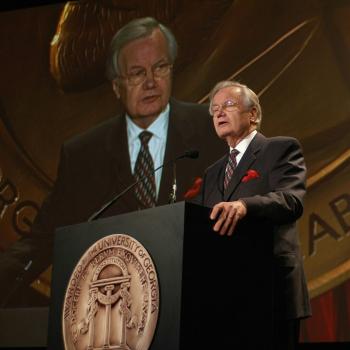
Reading the entire Bible can be a daunting prospect, especially if you are new to the Christian faith and/or want to better understand Christian beliefs. It’s a long book, but it reveals how people have dealt with many of the same problems we encounter today. It also teaches us how to live our best life and opens windows into a relationship with the Lord. My main goals for writing this article are to help you find the Bible that’s best for you and to offer suggestions about how to read the Bible.
You may, of course, decide to jump in immediately and download a free Bible app, buy an inexpensive Bible at Walmart, Goodwill or a dollar store, and start reading. In that case, skip Finding the Best Bible for You, below, and go to the next major section, How to Read the Bible.
Finding the Best Bible for You
First things first: My focus is the Protestant Bible as I am Protestant, but Patheos also has articles to help Catholics and members of the Eastern Orthodox Church, namely contributor Billy Kangas’s post What Bible Do Catholics Use? and the Patheos Religion Library’s information about Eastern Orthodox Church scripture.
But before we go any further, let me emphasize one important point: Protestants, Catholics and Eastern Orthodox Christians may look at some things differently and disagree about some details, but we all share several core beliefs. They are the beliefs that make all of us Christian.
- There is one and only one God who takes the form of three persons (God the Father, God the Son and God the Holy Spirit), which is called the Trinity.
- God is omniscient, omnipotent and benevolent.
- Jesus Christ is the divine Son of God.
- Salvation comes through Christ.
How Is the Bible Put Together?
The Protestant Bible contains two major sections: the Old Testament and the New Testament. The Old Testament contains 39 books that teach us how to live moral and godly lives, recount God’s history with the Jewish people who descended from Abraham, and prepare us for the coming of Christ in the New Testament.
The New Testament has 27 books that fulfill the promises of the Old Testament, according to Christian belief. It focuses on the life, death, resurrection and the important teachings of Jesus Christ.
Deciding What’s Important to You
Numerous versions and translations of the Protestant Bible exist, including the King James Version, published in 1611, and the New Living Translation, published in 1996.
The words version and translation may seem interchangeable, but they are not. A version may be a translation of the original text or a paraphrase that isn’t directly from the original. A translation, on the other hand, comes directly from the Bible’s original languages of Hebrew, Greek and Aramaic.
So, ask yourself whether it’s important to have one type of Bible rather than the other. My preference is a translation.
Some conservative Protestants believe the King James Version (KJV) is the definitive Bible and consider other versions and translations misleading. But I have a problem with the KJV.
My problem is that the KJV’s archaic language can be difficult to understand. The language is beautiful. Make a joyful noise to the Lord all the earth is more soothing to the soul than Let’s all get together and sing to God.
But some of the words in the KJV don’t necessarily mean what they meant 400+ years ago. For example, the KJV uses the word fear in reference to God. Modern readers may interpret the words fear God to mean be afraid of God, as I once did, when the actual meaning is to stand in awe of God.
If the archaic language of the King James Bible isn’t for you, consider some of the alternatives. One excellent translation is the New American Standard Bible. The NAS is written in a formal style, but it is more readable than the King James Version. It is highly respected as the most literal English translation of the Bible, according to Bible Study Tools.
My favorite Bible is the New Living Translation (NLT), which was created by more than 90 leading Bible scholars who based their translation on the original Hebrew, Greek and Aramaic texts. NLT’s accuracy and use of modern language appeal to me.
The Bible Study Tools website can help you with your search for a Bible. It provides side-by-side comparisons of scripture from various versions and translations.
To compare versions of John 3:16, for example, simply type compare Bible verse translations at your search engine’s prompt and then type John 3:16. Following is an excerpt of the list you may see:
King James Version: For God so loved the world, that he gave his only begotten Son, that whosoever believeth in him should not perish, but have everlasting life.
New American Standard Bible: For God so loved the world, that He gave His only begotten Son, that whoever believes in Him shall not perish, but have eternal live.
New Living Translation: For this is how God loved the world: He gave his one and only Son, so that everyone who believes in him will not perish but have eternal life.
How to Read the Bible
Hopefully, these tips on how to read the Bible will help you get started:
- Select a quiet and comfortable place for your Bible readings such as a favorite chair or nook in your home.
- Find a time when you can read the Bible without interruption every day, whether it’s in the early morning before your family gets up, at lunch or before you go to bed at night. Setting aside a specific time for daily Bible study will help you make it part of your day.
- If you miss a day, simply resume your Bible reading the following day.
- Fix a cup of tea or coffee before you get started.
- Have pen and paper ready.
- Begin with a prayer in which you thank God for your blessings and ask him to help you understand the scripture and his will for you.
- It’s fine is begin your readings with Genesis 1:1 in the Old Testament or Matthews 1:1 in the New Testament. But another good place to start is the Gospel of John, which is the fourth book in the New Testament. It’s a clear and simple introduction to the faith. It also tells you about who Jesus (is) and what He said. For example, in John 14:6, Jesus said: ‘I am the way, the truth and the life. No one can come to the Father except through me,’ explains Kimberlee Bousman, who is a graduate of Dallas Theological Seminary and writer and editor with New Life Ministries. But it’s also alright to start at the beginning of the Bible with Genesis 1:1.
- Start reading in 5- 10- or 15-minute increments each day rather than immediately trying a longer period or tackling a chapter per day.
- Don’t rush through your readings. Think about what you have read, use the internet or study sections of your Bible to answer questions you have, look up words you don’t quite understand and take notes or write in a journal.
- Pray about what you have read and ask God to help you understand it.
- Find a good Bible study online or at a church near you. I’m attending two Bible studies that meet once a week. One is a Zoom class and the other is in person.
- Ask questions!
- Begin applying what you have read to your life.













